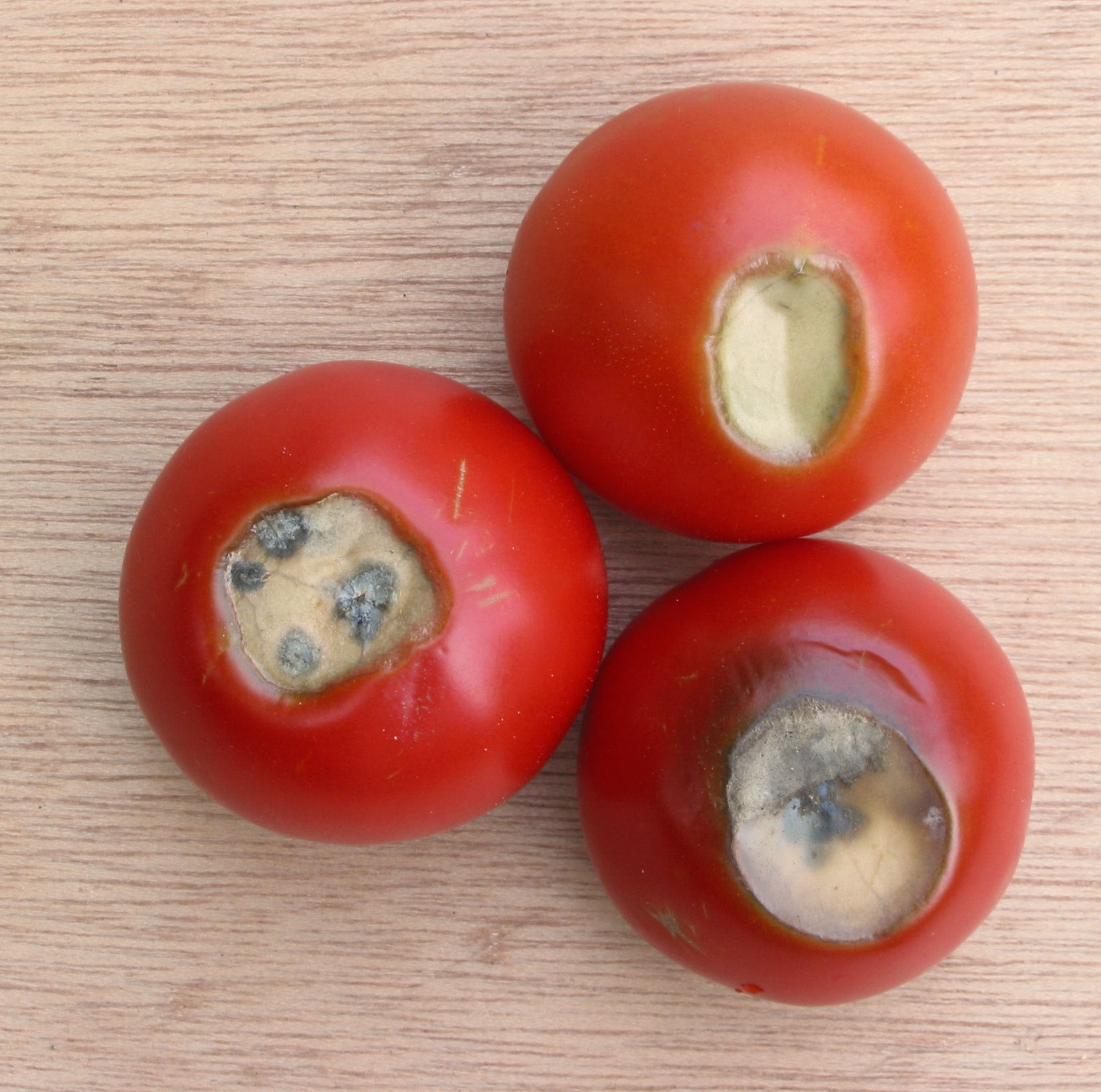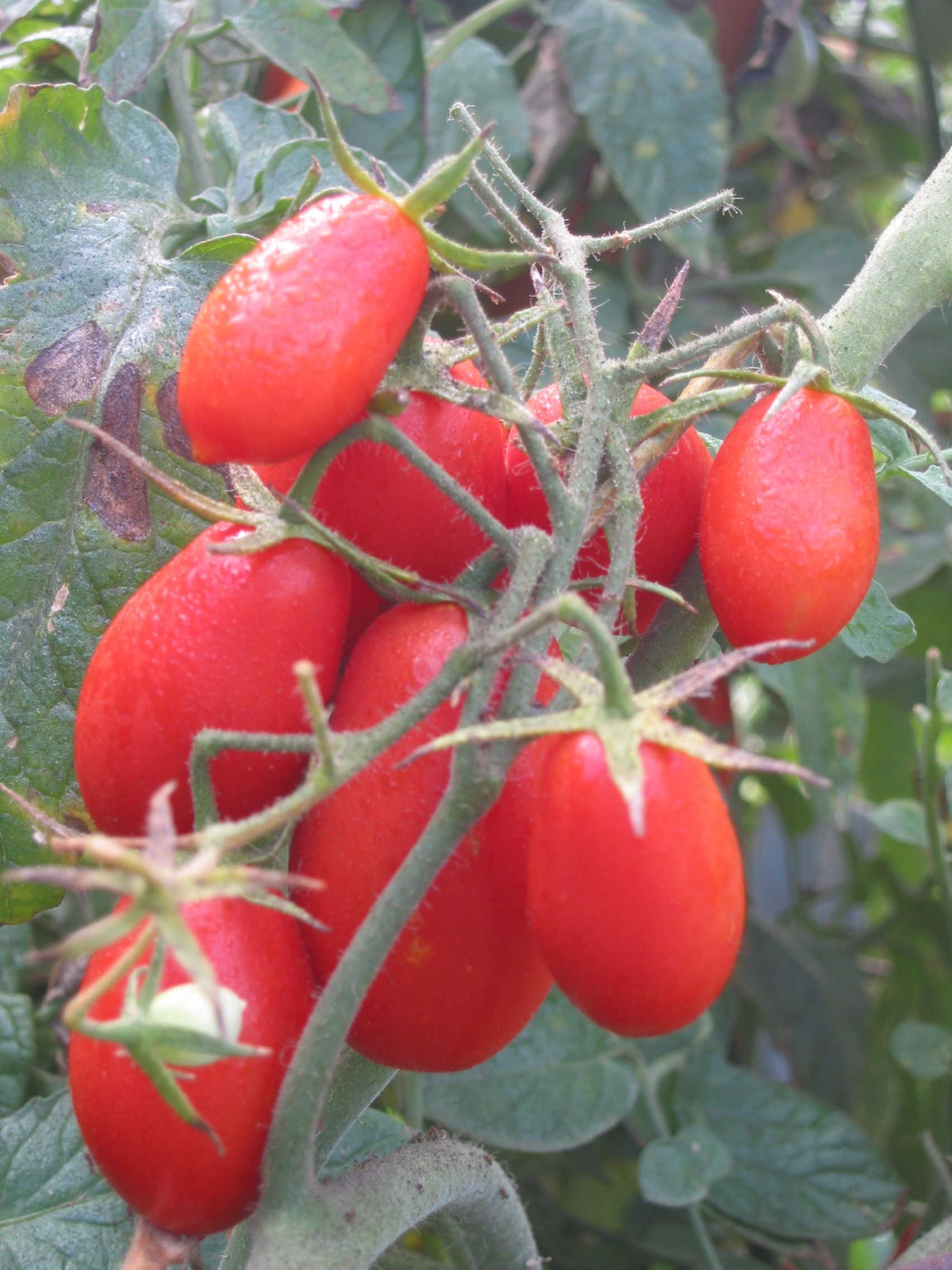Success with early tomatoes?
Written for the Davis Enterprise, March 25, 2010
Temperatures March 16 - 20 have been running 7 - 8 degrees above average for the time of year. Highs in the low 70's are causing spring fever, and we begin our annual public education campaign about when it is appropriate to plant summer vegetables. The widespread availability of vegetable starts is confusing - it must be time to plant them if stores have them, right? Folks want to get started! But planting summer vegetables in March, and even early April, is really jumping the gun.
Why do stores sell them early? Because you want them.
What happens if you plant too soon? They fail to thrive, at least at first.
Is there anything you can do to get early fruit? Yes! But you will also get great results if you just wait a few weeks.
When do we plant tomatoes?
You can check the night temperatures or soil temperatures, plant by the calendar, or use the posterior test. Or you can use phenology; more on this later.
1. Night temperatures: when the nights are consistently 50 - 55 degrees, the soil is likely to be warm enough for seedlings to make good root growth.
Some recent night temperatures:
March 11: 30 degrees F!
March 13: 35.
March 15: 37.
March 18: 42.
As of this writing, night temperatures are expected to be in the low to mid-40s through the next week.
2. It is really the soil temperature we are concerned about. We want soil to be at least 60 degrees. You probably don't have a soil thermometer (what a great gift idea!), so you can check out the weather site at ipm.ucdavis.edu for current readings at weather stations all across California.
Davis soil temperature as of March 16: 51 degrees.
3. If you prefer to plant by the calendar, we usually reach the desirable soil temperatures in late April. Optimal tomato-planting is anytime from late April through May, and plants set out in June will still have time to give good yields here.
4. The posterior test: put on some shorts (if you're modest) and go sit on the soil. If you find it uncomfortably cold, so will your tomatoes.
Problems with early planting.
Far be it from me to discourage anyone from purchasing tomato seedlings if the spirit moves you. But don't put them in cold soil! It is better to keep them in the pots until the soil warms up.
Why? The soil in the containers will be at (or nearly at) air temperature. If the pot is sitting in the sun, the soil will be even warmer. The soil in your garden warms up much more slowly. So for a significant percentage of the day and night, the soil in the pots will be warm and roots will continue to grow.
Seedlings planted into cold soil sulk. Roots don't develop well. They have difficulty absorbing nutrients, and the plants will show deficiencies. New growth is very slow, if it occurs at all. You don't gain anything from early planting in the open ground!
So what to do with those young vegetables?
Set the young seedlings in a warm area (direct sun is ok at this time of year) and keep them watered. If they are root-bound, transplant them into larger containers. A black pot is best, as it will absorb heat and warm up the roots. Loose, fast-draining soil will enhance root growth. Light fertilizer is helpful; fish emulsion is great.
Meanwhile, you can get the garden bed ready for later planting. Breaking the soil surface and adding compost helps the sun's warmth penetrate. Amend the soil with good quality compost. If it doesn't contain manure or fertilizer add some of that as well. Mound the area up a bit and sprinkle it with water.
Is there anything that helps warm up the soil?
Anything that elevates the soil. A raised planter warms up more quickly. Raised vegetable beds can be planted 2 - 3 weeks ahead of open soil. As you dig in your compost, you can simply pile up the soil where you're going to plant to create mounds. Dig furrows for irrigation, and use the soil from those to create raised ridges (this is how row crops are grown).
Various devices are marketed to help warm the soil, working like greenhouses, such as Walls-o-water and Hot Kaps. You can fashion your own mini-greenhouse out of 2 liter soda bottles or plastic milk containers: cut off the bottom and sink it in the soil over the plant for a few weeks. Seedling blankets can be spread over the bed and anchored securely to create a local greenhouse effect.
Which varieties to choose?
Over a hundred varieties of tomatoes are available from growers in the Sacramento region. I always recommend a mix of hybrids and heirlooms: a couple of good-yielding hybrids, at least one cherry type, a cooking tomato or two, and some colorful heirloom types.
For early production include small-fruited varieties such as SunGold and Juliet, and varieties that set fruit under cool conditions such as Early Girl. These also happen to be outstanding producers throughout the season.
Tomatoes that flower early may disappoint you at first.
Cool nights often prevent flowers from setting fruit. Many varieties will drop their blossoms without setting fruit if the night temperatures drop below 50 - 55 degrees, as often happens here in April and early May. Just be patient. But certain varieties such as Early Girl and Oregon Spring will set under cooler conditions.
A more common problem with the fruit that sets on plants that have been planted too early is blossom-end rot.
Blossom-end rot is a disorder that causes the bottom of the fruit to get brown and mushy. The cause appears to be simply environmental: low temperatures at night, fluctuating temperatures, watering too often, etc. Ammonia fertilizer is linked to it, so some forms of plant food can be a problem. But basically: just pick off the fruit that are affected, water more deeply and don't allow the plant to get severely drought stressed (daily watering is probably not necessary unless you have unusually fast-draining soil or are growing in a container). The next fruit will probably be fine. Mostly because of low soil temperature, it's usually a problem with the first tomatoes, peppers. and squash that set in the season and the rest come along fine.
As the roots develop and the soil warms, the problem will disappear and subsequent fruit will develop normally.
For a long time, blossom-end rot was thought to be caused by a deficiency of calcium, either in the soil or in the plant. Research indicates that the apparent calcium deficiency is not the cause of the problem. Applying calcium won't prevent it. Mostly it's just a matter of getting the soil temperatures warmer, and keeping the soil evenly moist while the young plant is developing.
What about other summer vegetables?
It won't harm tomato plants to go in early. They will sit, curl their leaves, turn kind of purplish due to the inability of the roots to take up nutrients, but when the soil warms they will begin normal growth. But don't even consider planting peppers and eggplant yet. These require much warmer soil temperatures: 70 degrees minimum! If you plant them in cold soil, they will be stunted all season. May-planted peppers always out-yield April-planted ones.
Other vegetables you can plant early include beans, corn, and potatoes, and cucumbers and summer squash.
o Beans need careful watering when planted in cool soils. Prepare the soil by turning it and blending in compost. Then plant the seeds and water thoroughly. Don't water again until the seedlings emerge, else the seeds are likely to rot.
o Some corn varieties will germinate and grow unevenly in planted in colder soils. Plant Early Sunglow, or standard old-fashioned corn varieties such as Golden Cross Bantam. White corn such as Silver Queen, and the newer extra-sweet and sugar-enhanced varieties really require warm soil: plant them in May, and do successive plantings into July.
o Potatoes are easily planted anytime in the spring. Buy certified disease-free seed potatoes. Cut each into 2 - 3 pieces, making sure each piece has an "eye." Let the pieces sit for at least 24 hours to scar over the cuts. Then plant them a foot apart in loose soil. Be careful not to over-fertilize potatoes as that can lead to excess leafy material and reduced tuber yields.
You still have time to do a last planting of cool-preferring root vegetables such as beets and carrots. It is late for the other winter vegetables. Broccoli, Brussels sprouts, cabbage, cauliflower, lettuce, and spinach will simply go to flower if planted after March. One exception: Swiss chard is a leafy green you can plant and grow year-around.
In addition to peppers and eggplant and the extra-sweet corns, other vegetables that really require warm soil include lima beans, cantaloupe, okra, pumpkins, winter squash, and watermelons. These are the real heat-lovers: plant them in May or June.
With gardening, timing can be important. For tomatoes, little is gained, but little is lost, by early planting. For peppers and eggplants, procrastination pays off in greater growth and yield.
----------
Phenology.
Greek for "science of appearances," it is the study of periodic biological phenomena. Gardeners have historically used phenology to determine when weather conditions allow planting certain crops, or to predict pest cycles (crabgrass seeds sprout when forsythias are blooming). So what say the phenologists? Collected from various sources:
"When the flowering dogwood is in peak bloom it is time to plant tomatoes, early corn and peppers."
Hm. No dogwoods in Davis.
"Plant tomatoes and peppers when daylilies start to bloom."
Plausible. Some are in bud now, but most are a little ways' off.
"Plant corn when oak leaves are the size of a squirrels' ear."
This assumes some prior knowledge about the size of squirrel ears, and probably varies by oak species.
Local phenologists, feel free to send along your secrets!
 Blossom end rot is a disorder, not a disease. It is a nutritional deficiency caused by low or fluctuating temperatures, and exacerbated by watering too frequently. Common on the first tomatoes that set in the season, the plants outgrow the problem as the soil warms up. Simply discard the affected fruit and wait for warmer weather.
Picture source: Wikimedia Commons.
http://commons.wikimedia.org/wiki/File:Tomaat_neusrot_(Solanum_lycopersicum)_.jpg
Blossom end rot is a disorder, not a disease. It is a nutritional deficiency caused by low or fluctuating temperatures, and exacerbated by watering too frequently. Common on the first tomatoes that set in the season, the plants outgrow the problem as the soil warms up. Simply discard the affected fruit and wait for warmer weather.
Picture source: Wikimedia Commons.
http://commons.wikimedia.org/wiki/File:Tomaat_neusrot_(Solanum_lycopersicum)_.jpg
 Want the first tomatoes on your block? Small-fruited types develop fastest. Juliet is a hybrid tomato with abundant miniature plum-shaped fruit. They are very meaty, so excellent for cooking as well as salads and fresh eating. Cherry tomatoes such as Sweet 100 and SunGold are also popular.
Want the first tomatoes on your block? Small-fruited types develop fastest. Juliet is a hybrid tomato with abundant miniature plum-shaped fruit. They are very meaty, so excellent for cooking as well as salads and fresh eating. Cherry tomatoes such as Sweet 100 and SunGold are also popular.
© 2010 Don Shor, Redwood Barn Nursery, Inc., 1607 Fifth Street, Davis, Ca 95616
www.redwoodbarn.com
Feel free to copy and distribute this article with attribution to this author.
Click here for Don's other Davis Enterprise articles
